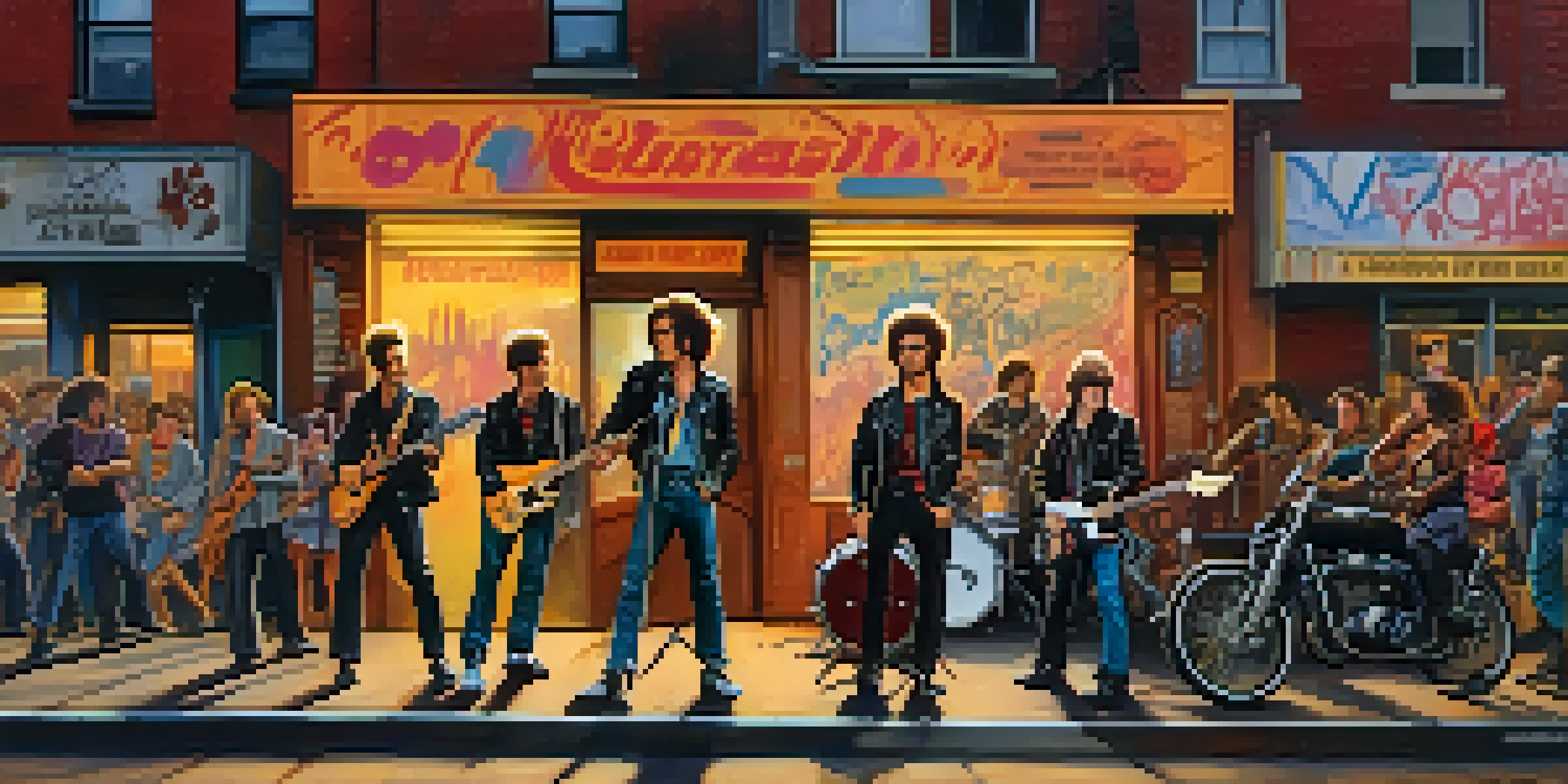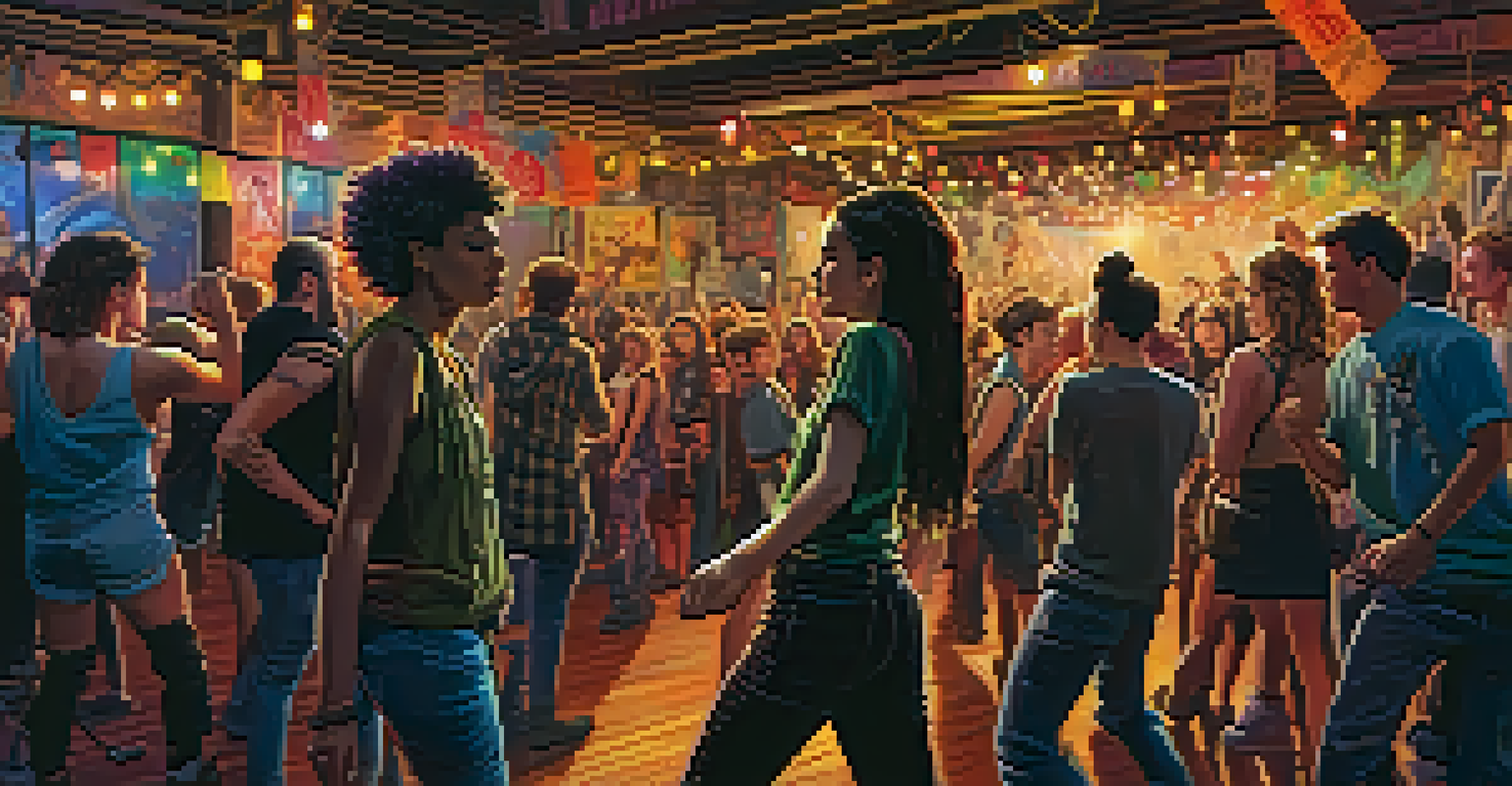Pioneers of Punk: NYC's Role in the 1970s Music Revolution

The Birth of Punk: NYC's Underground Scene
In the early 1970s, New York City became a melting pot for creative minds and rebellious spirits, setting the stage for punk music to emerge. Venues like CBGB and Max's Kansas City became breeding grounds for artists looking to break free from mainstream norms. This underground scene was characterized by raw energy and a DIY ethos, allowing musicians to express their frustrations and ideologies without filters.
Punk was defined by its refusal to conform, by its embrace of individuality and creativity.
The gritty streets of NYC served as both inspiration and backdrop for many punk bands. Groups like The Ramones and Television began to develop their unique sounds, blending rock with elements of garage and art music. Their music resonated with the disillusioned youth of the time, who sought a voice amidst social and political upheaval.
As these bands gained traction, they created a community that fostered collaboration and experimentation. This tight-knit network of musicians and artists was pivotal in defining the punk genre, leading to the birth of a rebellious subculture that would influence countless generations.
Key Figures: Icons of the NYC Punk Movement
Several iconic figures emerged from the NYC punk scene, each contributing to the genre's evolution. One notable name is Patti Smith, whose poetic lyrics and androgynous style challenged traditional gender roles and expectations. Her debut album, 'Horses,' released in 1975, is often cited as a cornerstone of punk rock.

Another significant figure is Iggy Pop, whose raw stage presence and wild performances set the standard for punk frontmen. With his band, The Stooges, he pushed the boundaries of music and performance art, influencing many punk bands that followed. His chaotic energy on stage epitomized the spirit of punk: uninhibited and rebellious.
Punk's NYC Roots and Community
The punk movement thrived in NYC's underground scene, fostering a community of musicians and artists who challenged mainstream norms.
Then there’s Debbie Harry of Blondie, who blended punk with new wave and disco, showcasing the genre's versatility. Her unique style and magnetic presence not only made Blondie a commercial success but also helped to broaden the appeal of punk music beyond its underground roots.
The Sound: Defining Characteristics of Punk Music
Punk music is often characterized by its fast tempos, short song durations, and simple chord structures. This stripped-down sound was a direct response to the elaborate productions of the 1970s rock scene. Bands like The Ramones exemplified this with their catchy hooks and straightforward lyrics, creating songs that were both accessible and impactful.
The music is a reflection of the times, the anger, the rebellion, and the need for change.
Moreover, punk music often features an aggressive vocal style that conveys raw emotion and urgency. This vocal delivery was not just about the music; it was also a form of protest against societal norms and injustices. The energy and attitude embedded in punk songs resonated deeply with listeners who felt marginalized or unheard.
The lyrical themes often revolved around rebellion, anti-establishment sentiments, and everyday struggles. Songs served as anthems for a generation seeking change, providing a soundtrack to the discontent and frustration that defined the era.
Fashion and Identity: Punk's Visual Revolution
Punk music wasn’t just about sound; it also sparked a visual revolution that transformed fashion and identity. The punk aesthetic was characterized by torn clothing, leather jackets, and bold hairstyles, often featuring vibrant colors and unconventional cuts. This look was a form of self-expression, allowing individuals to showcase their defiance against societal expectations.
Stores like CBGB became not only music venues but also fashion hubs where punk enthusiasts could find unique clothing and accessories. Designers like Vivienne Westwood played a crucial role in popularizing punk fashion, mixing high fashion with street style to create an iconic look that still resonates today.
Influential Punk Icons
Iconic figures like Patti Smith and Iggy Pop shaped the genre's evolution, each bringing unique styles and performances that defined punk's spirit.
Punk fashion was more than just a trend; it represented a lifestyle choice and a sense of belonging to a community. It empowered individuals to embrace their uniqueness, encouraging them to reject conformity and celebrate their identities in a world that often pushed for uniformity.
The DIY Ethos: Empowering a Generation
One of the most significant aspects of the punk movement was its DIY (Do It Yourself) ethos, which encouraged artists to take control of their music and marketing. Rather than relying on major record labels, many punk bands chose to self-produce and distribute their music. This approach not only democratized the music industry but also empowered artists to stay true to their vision.
The DIY attitude extended beyond music to include artwork, merchandise, and even venues. Many bands created their own flyers, album covers, and promotional materials, fostering a sense of community and collaboration. This grassroots approach allowed for a more authentic connection between artists and their audience.
As a result, the punk movement inspired countless individuals to pursue their artistic passions, regardless of their backgrounds or resources. The message was clear: anyone could participate in the music scene, and creativity had no boundaries.
Legacy: Punk's Lasting Impact on Music and Culture
The impact of NYC's punk scene in the 1970s continues to resonate in today's music and culture. Many contemporary genres, including pop punk, indie rock, and even hip-hop, have drawn inspiration from punk's raw energy and rebellious spirit. Bands like Green Day and Paramore carry the punk torch, introducing new audiences to the genre's essence.
Moreover, the punk movement laid the groundwork for future subcultures, encouraging the rise of alternative music scenes worldwide. It sparked a desire for authenticity in art and performance, influencing everything from fashion to visual arts and literature. Punk's message of individuality and resistance remains relevant, inspiring new generations to challenge the status quo.
DIY Ethos Empowering Artists
The DIY ethos of punk encouraged artists to take control of their music and creativity, leading to an authentic connection with their audience.
The legacy of NYC punk is not just in the music; it's in the spirit of rebellion and creativity that it ignited. As we reflect on this transformative era, it's clear that the pioneers of punk have left an indelible mark on the cultural landscape, one that continues to inspire and empower.
Conclusion: Celebrating NYC's Role in Punk History
As we look back at the 1970s, it’s clear that New York City was pivotal in the development of punk music. The city's vibrant scene fostered creativity and innovation, allowing diverse voices to emerge and shape the genre. From iconic venues to influential artists, NYC's contributions to punk are both profound and enduring.
The stories of punk pioneers remind us of the power of music as a catalyst for change and expression. Their legacy inspires us to embrace our individuality and challenge societal norms, encouraging us to find our unique voices in a world that often tries to silence them.

In celebrating NYC's role in the punk revolution, we honor not just the music but the spirit of rebellion and creativity that continues to resonate today. Punk may have originated in the gritty streets of New York, but its impact is felt globally, reminding us that art knows no boundaries.